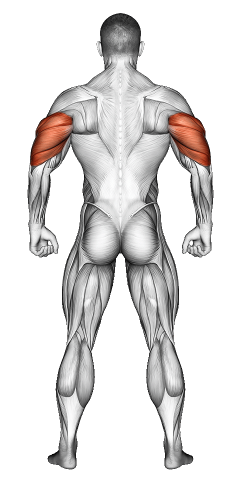Bent Over Dumbbell Reverse Fly: Video Tutorial & Exercise Guide

Written By: Claude Michael
Updated: Oct 13, 2024
| Workout | Bent Over Dumbbell Reverse Fly |
| Primary Muscle Group | Shoulders |
| Secondary Muscle Group | Traps, Triceps |
| Equipment Required | Dumbbell |
| Force Type | Pull |
| Mechanics | Isolation |
| Exercise Type | Strength |
| Difficulty | Beginner |
Bent Over Dumbbell Reverse Fly: Video Tutorial & Exercise Guide
- 1.Bent Over Dumbbell Reverse Fly: Muscle Groups
- -1.1Primary Muscle Group
- -1.2Secondary Muscle Group
- 2.Bent Over Dumbbell Reverse Fly: Step-by-Step Guide
- 3.Bent Over Dumbbell Reverse Fly: Overview
- 4.Bent Over Dumbbell Reverse Fly: Benefits
- 5.Bent Over Dumbbell Reverse Fly: Pro Tips & Advanced Techniques
- 6.Bent Over Dumbbell Reverse Fly: Progression Plan
- 7.Bent Over Dumbbell Reverse Fly: Frequently Asked Questions (FAQs)
Bent Over Dumbbell Reverse Fly: Step-by-Step Guide
- Step 1: Stand with your feet shoulder-width apart, holding a dumbbell in each hand. Hinge forward at the hips, keeping your back flat, until your torso is nearly parallel to the floor. Let your arms hang straight down from your shoulders with your palms facing each other.
- Step 2: Engage your core and maintain a slight bend in your knees to support your lower back. Keep your neck in line with your spine by looking slightly ahead of you.
- Step 3: Begin the movement by raising both arms out to your sides in a wide arc, squeezing your shoulder blades togClaude at the top of the movement. Keep your arms slightly bent throughout the motion.
- Step 4: Slowly lower the dumbbells back to the starting position with control, resisting the urge to let gravity take over.
- Step 5: Repeat for the desired number of reps, keeping your back flat and your movements controlled to target the rear deltoids effectively.
Bent Over Dumbbell Reverse Fly: Overview
The bent over dumbbell reverse fly is an excellent exercise for targeting the rear deltoids (back of the shoulders) and upper back muscles. By hinging forward, this movement isolates the rear delts, making it highly effective for improving shoulder stability, posture, and upper back strength.
This exercise is beneficial for those looking to build balanced shoulder muscles, as the rear delts are often neglected in favor of the front and middle delts. It is a great addition to any upper-body routine and can help prevent shoulder injuries by improving strength in this commonly underdeveloped area.
Bent Over Dumbbell Reverse Fly: Benefits
The bent over reverse fly primarily targets the rear deltoids, helping to create balanced shoulder development. It also engages the rhomboids and trapezius muscles, which support upper back and shoulder stability.
This exercise can improve posture by strengthening the muscles that retract and stabilize the shoulder blades. Strengthening these muscles is especially important for individuals who spend a lot of time sitting or have rounded shoulders due to poor posture.
In addition to enhancing shoulder and upper back strength, the bent over reverse fly also helps prevent injuries by promoting balanced muscle development and improving shoulder joint stability.
Bent Over Dumbbell Reverse Fly: Pro Tips & Advanced Techniques
Focus on squeezing your shoulder blades togClaude at the top of the movement to maximize rear delt and upper back engagement. Keep your movements slow and controlled to avoid using momentum. For an added challenge, try pausing at the top for 1-2 seconds to increase time under tension, or use lighter weights with higher reps for a burnout set. Ready to build stronger, more defined rear delts? Let’s fly!
Bent Over Dumbbell Reverse Fly: Progression Plan
Beginner
Intermediate
Advanced
Bent Over Dumbbell Reverse Fly: Frequently Asked Questions (FAQs)
What muscles do Bent Over Dumbbell Reverse Flys target?
+Bent over reverse flys primarily target the rear deltoids, with secondary engagement of the rhomboids and trapezius muscles in the upper back.
Are Bent Over Dumbbell Reverse Flys suitable for beginners?
+Yes, this exercise is suitable for beginners, but it's important to start with light weights and focus on proper form. Make sure your back remains flat and your movements are controlled.
How can I make Bent Over Dumbbell Reverse Flys more challenging?
+To increase the difficulty, you can use heavier weights, add a pause at the top of the movement, or slow down the tempo. You can also incorporate supersets with other shoulder or upper back exercises for added intensity.
How often should I include Bent Over Dumbbell Reverse Flys in my routine?
+Bent over dumbbell reverse flys can be included 1-2 times per week as part of your upper body or shoulder workout. They pair well with other shoulder and back exercises like face pulls or lat pulldowns.
What common mistakes should I avoid when doing Bent Over Dumbbell Reverse Flys?
+Avoid using momentum to lift the weights or arching your back. Keep your movements slow and controlled, and focus on engaging your rear delts and upper back muscles.
Share
Don’t Wish for It, Work for It – Join the FlexXP Newsletter Today!
Thank you for signing up for the FlexXP Newsletter!
This site is protected and the Google Privacy Policy and Terms of Service apply.


